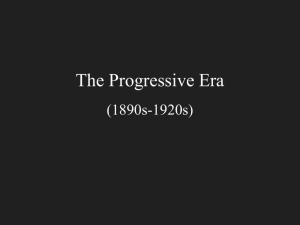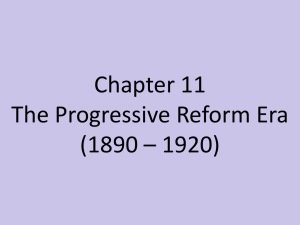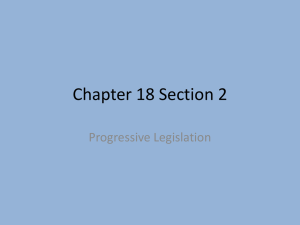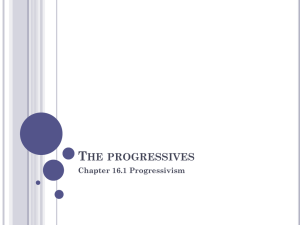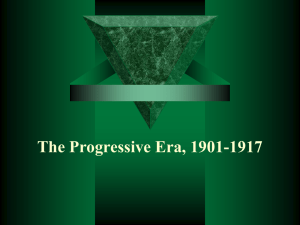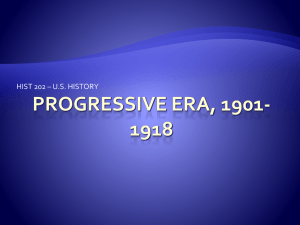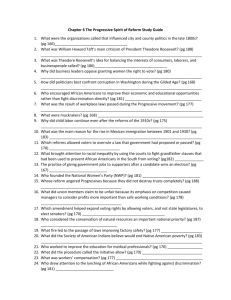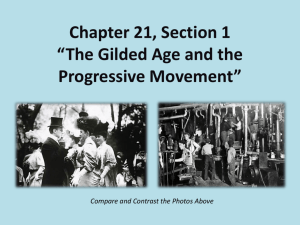The Progressive Era
advertisement
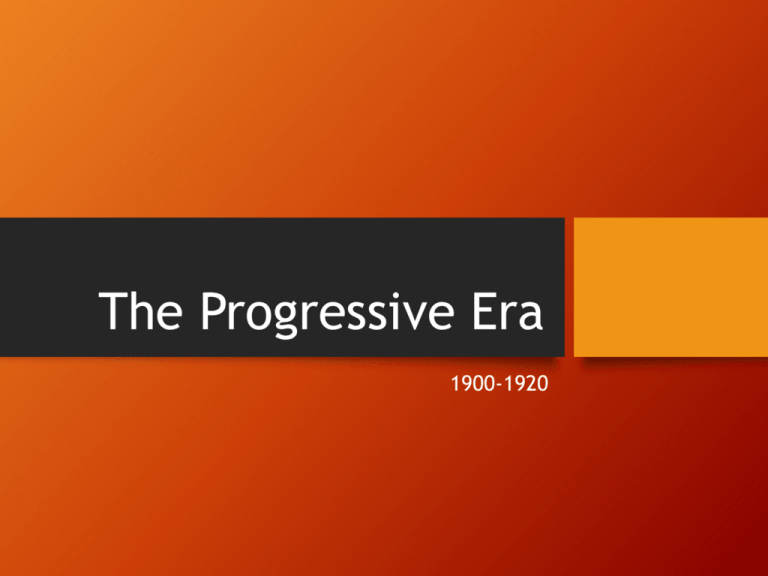
The Progressive Era 1900-1920 Do Now: Copy these notes into your notebook Progressivism • Industrial Revolution led to prolonged problems in the country which aroused a spirit of reform known as progressivism • Who were the Progressives? • People from all walks of life participated in the Progressive movement • Majority were native born, middle or upper class, and college educated • Progressive journalists helped spread reform message • Investigative journalists known as muckrakers were responsible for exposing society’s wrongs • Photographers and journalists who used vivid images and descriptions of society’s problems to shock society into action • Given their name based on speech by Teddy Roosevelt in 1906 • A muckrake was instrument used to rake up muck, dirt, and filth Successful Reforms Do Now: Copy into the “Notes” section of your binder • Progressivism was NOT a unified movement with a single set of principles • Sometimes principles even contradicted one another • Ex: White Southern Progressives vs. African Americans • Three themes behind Progressivism 1. 2. 3. Anger over excess of industrial capitalism and urban growth Emphasized community action, opposed social Darwinism Believed in need for citizens to intervene politically and morally to improve social conditions • Sources of inspiration 1. 2. Evangelical Protestantism/social gospel movement Natural and social scientists who developed rational measures for improving human condition Problems Progressives Had… Alliance between big business and government • “Shame of the Cities” by Lincoln Steffens Ida Tarbell published devastatingly factual expose of the Standard Oil Company • • • Her father had been ruined by the company David G. Phillips wrote series in Cosmopolitan titled “The Treason of the Senate” • • Charged that 75 of the 90 Senators did not represent the people at all but the railroads and trusts Fearing legal reprisals from powerful companies, muckraking magazines went to great pain and expense to check and verify their material • • Paid as much as $3,000 to verify a single Tarbell article • Malpractices of life-insurance companies and tariff lobbies • Roasted trusts and the corrupt massing of American fortunes • Social evils including “white slave” traffic in women, the slums, appalling number of industrial accidents, subjugation of 9 million Blacks, abuses of child labor, vendors of potent patent medicine (often heavily spiked with alcohol) What are political machines and why are they bad? • Political machines are organizations that manage, sometimes illegally, the administration of local and state governments. • Favoritism, sketchy deals, and nepotism (giving positions to friends) are all features of the political machine • They often work together with municipal (local) governments and have often come to dominate the city in which they operate • Most machines are corrupt financially and politically • In return for performing favors for residents, especially new immigrants, the recipient was expected to be politically loyal to the machine • The most famous machine was “Boss Tweed’s Ring” which dominated NYC’s government during and after the Civil War As boss of Tammany Hall, the nickname of New York’s political machine, the Tweed Ring essentially ran the city and stole millions of dollars from it in the process The famous cartoonist Thomas Nast, who introduced the elephant and the donkey as symbols for the Republicans and the Democrats, exposed the corruption and abuses of the Tweed machine in a series of startling political cartoons • • • • Tweed eventually went to prison Progressives felt that political machines prevented changes from occurring in all areas of American society and so the first thing on their agenda was to curb the power of these machines Progressivism in the Cities and States • Attempts were made to ban child labor • Minimum wage and maximum hour laws to protect women workers were established • Workers’ compensation was set up to protect workers against on-the-job accidents • Pensions were provided for widows and children when the husband/father was killed on the job • Building codes and state inspections acts were passed. Designed to protect workers against hazardous working conditions (catalyst for this was the Triangle Shirtwaist Factory Fire) • Businesses such as railroads and insurance companies and the food industry were regulated. City Reforms • Progressive reform began at the local or city level because it was easier to implement than at the vast state or national level. Urban corruption from political machines was a major focus, resulting in the reorganization of local government using the commissioner-and city-manager-styles of management. City Commissioner Plan Cities hired experts in different fields to run a single aspect of city government. For example, the sanitation commissioner would be in charge of garbage and sewage removal. City Manager Plan A professional city manager is hired to run each department of the city and report directly to the city council. State Reforms • Reform governors such as Theodore Roosevelt of New York, Robert M. LaFollete of Wisconsin, and Woodrow Wilson of New Jersey, all helped get reforms passed in their respective states. In addition, reforms first proposed by the Populist Party were enacted in order to make state governments more responsive to the needs of the people. Secret Ballot Privacy at the ballot box ensures that citizens can cast votes without party bosses knowing how they voted Initiative Allows voters to petition state legislatures in order to consider a bill desired by citizens. Referendum Allows voters to decide if a bill or proposed amendment should be passed. Recall Allows voters to petition to have an elected representative removed from office. Direct Primary Ensures that voters select candidates to run for office, rather than party bosses. Federal Reforms • During the Progressive Era, the Federal Government passed an enormous amount of legislation designed to conserve the environment, tighten past economic regulations, preserve the health and safety of American citizens, and generally provide needed capitalist reforms. Newlands Reclamation Act (1902) Encouraged conservation by allowing the building of dams and irrigations systems using money from the sale of public lands. Elkins Act (1903) Outlawed the use of rebates by railroad officials or shippers Pure Food and Drug Act (1906/1911) Required that companies accurately label the ingredients contained in processed food items. Meat Inspection Act (1906) In direct response to Upton Sinclair's The Jungle, this law required that meat processing plants be inspected to ensure the use of good meat and health-minded procedures. Federal Reforms Continued… Hepburn Act (1906) Strengthened the Interstate Commerce Commission, allowing it to set maximum railroad rates. Federal Reserve Act (1913) Created 12 district Federal Reserve Banks, each able to issue new currency and loan member banks funds at the prime interest rate, as established by the Federal Reserve Board. Clayton Antitrust Act (1914) Strengthened the Sherman Antitrust Act by outlawing the creation of a monopoly through any means, and stated that unions were not subject to antitrust legislation. Federal Trade Act (1914) Established the Federal Trade Commission, charged with investigating unfair business practices including monopolistic activity and inaccurate product labeling. New Amendments to the Constitution • To provide a stable base of income for the Federal Government while providing graduated taxation, the 16th Amendment was passed. Political machines were weakened by the passage of the 17th Amendment which allowed state citizens to directly elect representatives to the U.S. Senate, instead of allowing partycontrolled state legislatures to do so. In addition, the Temperance Movement and the Women's Suffrage Movement finally paid off with the passage of the 17th Amendment and the 18th Amendment. 16th (1913) Graduated income tax 17th (1913) Provided for the direct election of U.S. Senators. 18th (1919) Prohibited making, selling, or transporting alcohol. 19th (1920) Provided women suffrage (voting).

